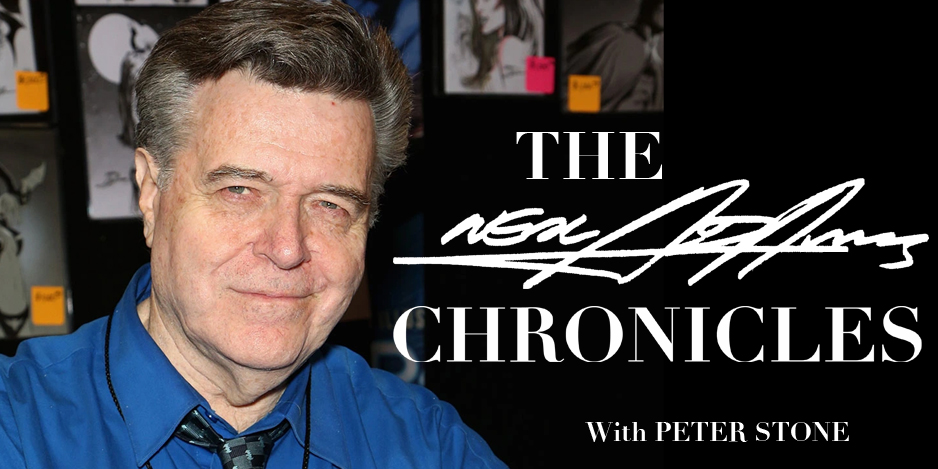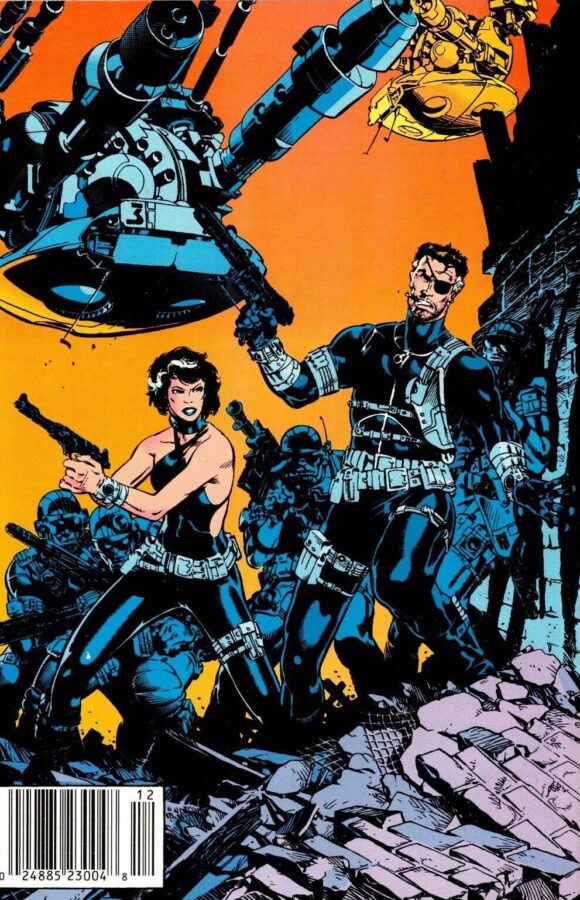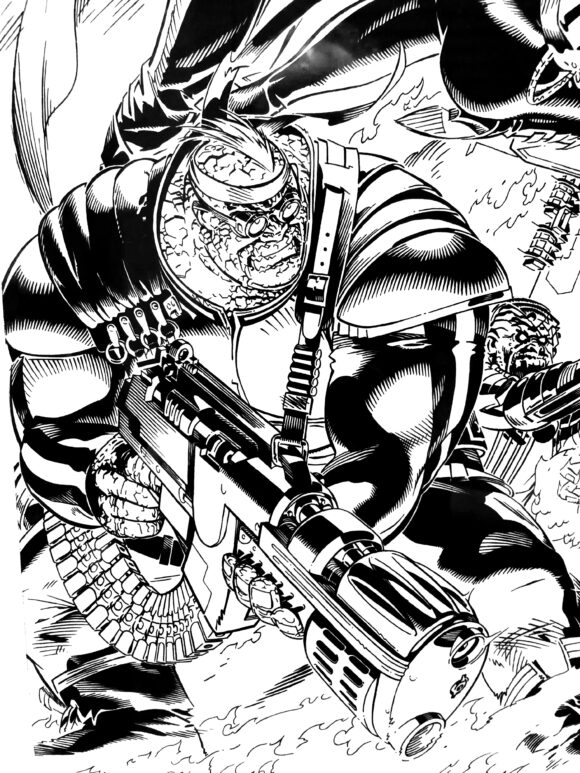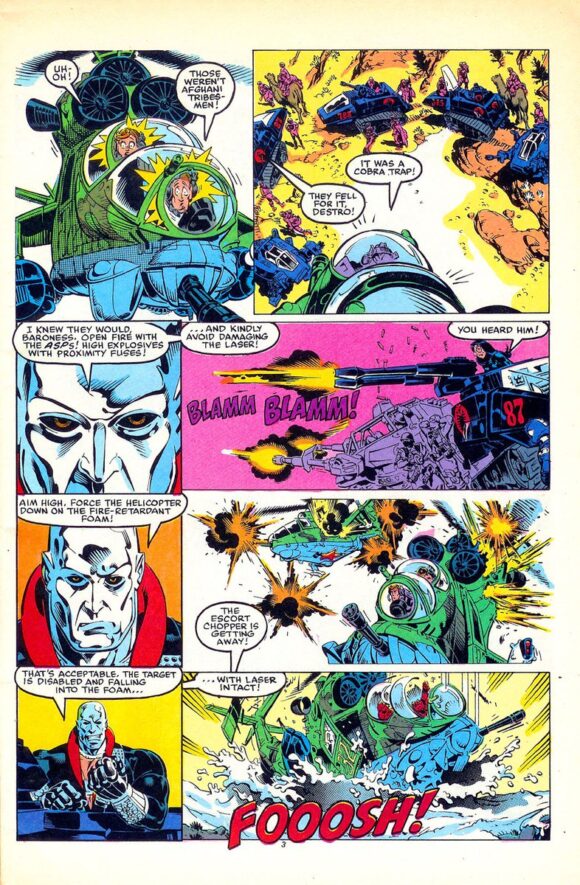THE NEAL ADAMS CHRONICLES: A birthday tribute to the Adams protege, who was born 68 years ago, on Oct. 1, 1955…

By PETER STONE
Many legendary comic book artists have unique, intense styles. For example, Alex Toth, John Buscema, Will Eisner, Moebius, Richard Corben, Travis Charest, and, of course, Neal Adams. Other, up and coming artists learn from these legends and evolve in their own directions. However, there are some whose styles are so unique and intense that it’s close to impossible to begin to replicate. One of those very few is Michael Golden.
Jack Kirby, the man who gave us practically everything, drew close to 20,000 pages of art. John Buscema (if the calculations are correct) drew even more. Curt Swan drew Superman for decades. Michael Golden drew a fraction of these numbers, but was as influential and deeply loved as any of them. (Maybe not Kirby, but close.) Michael’s work includes Avengers Annual #10 (written by Chris Claremont); G.I. Joe Yearbook #2 (written by Mr. G.I. Joe himself – Larry Hama); 11 issues of Micronauts; 12 issues of The ‘Nam (edited by Hama); Marvel Fanfare #1, #2 (Claremont again) and the absolutely brilliant #47; Jackie Chan’s Spartan X; Continuity Comics’ Toyboy #7 (Written by Neal from an idea by me); and the piece de resistance Bucky O’Hare! (Hey, there’s that Hama guy again!)

Of course, there are other individual stories, covers, pin-ups and portfolios but those above are the heavy hitters. The genre-changing stories that altered how fans viewed certain characters and situations.
To tell some of Michael’s story, we have to start with his long-time compatriot and writer Larry Hama. When Michael was just a young, eager lad, he had met Larry and because of their mutual love of long guns, military history and violent detonations, they became fast friends. (I’m assuming that’s why they liked each other, anyway.) Larry was once the great Wally Wood’s assistant and told me that on his very first day, Wally asked him if he had brought a gun. Larry, of course, said no. Wally opened a drawer and pulled out a spare handgun. “You can use this one for today.” Turns out the lunchtime recreation was bottle shooting in the nearby woods. That probably explains Larry’s later story subject matter. It makes perfect sense that Larry and Michael became friends.

Marvel Fanfare #47 back cover
Michael, I dare say, draws guns, planes, cars, helicopters and dinosaurs better than anyone in comics… ever. Unbeknownst to most, Michael also grew up around horses and can probably shoot the “eye out of a bird flying” to quote Unforgiven.
Moving on in our story, Michael showed Larry his portfolio and asked if he could get work in comics. Larry perused the art, immediately knowing exactly where to go and who to talk to. Larry was now the assistant to another great artist after Wally had passed away: Neal Adams. A little while later, Neal was turning the pages of the same Michael Golden portfolio at his 48th street studio. He bellowed to get DC Comics on the phone and within 20 minutes, Michael had work. Within a year, probably less, Michael was drawing Batman which (at the time) looked suspiciously like a certain Mr. Adams’ version of the Darknight Detective. That story wasn’t unique. That was Neal’s modus operandi: Get young, talented potential comic book artists work at Marvel or DC. Or in Michael’s case, Marvel AND DC.

As a side note, many talented and professional artists drifted their way through the halls of Continuity. A couple of them were Josef Rubenstein and Russ Heath who are important to our story. Joe ended up as Michael’s inker on Micronauts, but Russ provided the young Golden another tool for his rapidly growing belt. Michael, in his own words, was struggling to become a better inker of his own work since he was rarely happy with the company-provided inkers. Russ (one of the most talented artists this industry has ever seen), once watched Neal pencil and ink a beautiful face for one of his pages. Russ, working surely on a war story, asked Neal if he could see that face for a few minutes. Neal, egotistically thinking that Russ wanted to study his brilliant work, watched with horror as Russ put Neal’s page next to his and COPIED the face onto Russ’s own page. Line for f’ing line, Neal cried to me one day. “I hated and loved him at the same time. He was a genius.”
So, when Michael was penciling a Mister Miracle comic (Vol. 1, #25) for DC, Neal suggested that Russ ink that job. (As an intellectual exercise, I suggest those who are interested look at the issues BEFORE Mister Miracle #25 and then look at Issue #25. Russ’ inking taught Michael what inking was all about.) Neal also stacked the deck on that issue. He had his wife Cory (brilliant in her own right) color it and as a sidenote, Larry Hama was the editor of the title.

Mister Miracle #25
At around the same time, Larry had created a Funny Animal/Wally Wood story with a sprinkle of Star Wars and a few Wild Bunch jokes for the highly intelligent. It was called Buck Bunny. He quickly roped Michael into drawing this creator-owned, 49-page story, but it would take several years to complete it. Neal heard out the idea from Larry, saw the drawings from Michael and immediately decided to fund it, sell reproduction rights to European countries and become half owner so that Marvel and DC would never obtain it outright. However, when he presented it to a German publisher at the Frankfurt Book Fair, the representative said in a heavy German accent. “Bucks Bunny? We haf a Bugs Bunny.” Neal immediately saw the problem, but a short time later while landing in Chicago, his wife Marilyn commented that O’Hare sounded like a good rabbit name. Thus, with the creator’s approval, Bucky O’Hare was born.

Bucky and crew
In 1984, in the newly published anthology title Echo of Future Past from Neal’s new company Continuity Comics, the first eight pages of Captain Bucky O’Hare appeared next to Neal’s redrawn Transylvania story, Mudwogs; Virus by Jean Teule; and Tippie Toe Jones, by Lindley Farley and Louis Mitchell. It appeared in Europe and quickly became a graphic novel. In the very early ’90s, Bucky appeared on television, in toy stores and in video games. Animators and sculptors all said the same thing… Michael Golden seems to draw in 3-D, making their job so much easier. There is an entire second season of new characters and vehicles designed by Larry and Michael. Killer stuff.
Michael drew a Toyboy issue that Neal (and I) wrote. That issue inspired us to rethink Toyboy because it was so wonderfully drawn. Fun, exciting, and more than just a little science fiction. There was a game we played when pages came in. It was called “spot the white-out.” Surely, there must be white-out here somewhere, right? Nope. Pristine, perfect lines. Every page perfect. Michael even inked in the balloons. (There are more stories connected to this issue, but those are for another time.)

When Neal and those of us at Continuity Comics decided to try our hand at a crossover called Deathwatch 2000 in 1992-93, Michael agreed to draw the covers for the Armor title. The first issue takes place on the deck of an aircraft carrier so who could ask for something better for Mr. Golden? It’s a wraparound and it’s brilliant. While fire burns everywhere, the Hellbenders attack Armor, a character whose costume is made of weapons… glorious. In the background, we see the ornate carrier’s superstructure. There MIGHT be an empty space somewhere, but I don’t see it. Hardest working man in comics, fo’ sho’! Armor #2 featured laser die-cutting years before anyone else did it. It must be seen to be believed. Issue #3 is another wraparound with nuclear missiles. Issue #4 – an alien-looking deep sea squid monster and a sexy girl… tentacles everywhere. Issue #5 showcases the hero and some stone gargoyles. All in all, a great run of Golden covers. He even did a Ms. Mystic cover (#3) over a Neal Adams layout.
Finally, Michael drew eight pages of the Deathwatch 2000 conclusion before he was taken away to other projects. Three spreads and an individual page of easily some of the very best artwork this industry has ever seen. Someday the world will see them… I hope.

Toyboy #7
Then, there was the bright Monday morning in the middle of Deathwatch 2000. Sitting on my rough-hewn desk was a package from one of my personal favorite artists – Ernesto Infante. He had sent an entire issue of Megalith from his home through DHL in the Philippines. I carefully opened the package and went page by page through the images of wonder in front of me. We would send him good paper, but he always sent back something he was more familiar with… terrible paper. We were sure he was selling our paper on the comic book black market in Metro Manila. I opened a spread of the character of Mite from Hybrids and stared at it for a good long time. Brilliant work. Then, FedEx arrived with more wonder. An Armor cover by Golden. The very first one. It practically glowed with “Goldenness.” I stared at it for another half an hour, lost in my own religious experience. Finally, as if that wasn’t enough, Neal came in to work. He had stayed late at home this morning, finishing the spread for Valeria: The She-Bat #1.

Lying on my desk was a collection of the greatest comic art this world may have ever seen, in my opinion. At the time, Image was selling millions of copies of WildC.A.T.s, Cyberforce and Spawn. On my desk were pages from comics that might hit 100,000 copies, but there was so much talent there. Neal Adams, Ernesto Infante and Michael Golden. These three Continuity Comics artists were our Jim Lee, Mark Silvestri and Todd McFarlane – our heavy hitters. I could easily argue that they were better, but this is neither the time nor place. Michael had turned in one of, if not the best, cover Continuity ever produced. Its precision was breathtaking. The R.E.M. character, with her crosshatched lightning bolts was especially amazing — probably by Michael’s hand and not a ruler because they curve. For me, it was like seeing the inside of the Arc of the Covenant. If I looked too long, my face would melt. I will never forget that morning and seeing Michael’s work on Armor for the first time.

Toyboy #7
A last quick story about my association with Mr. Golden. When he and Larry were together and talking, you had two choices: 1) keep your festering gob shut tight or 2) be super-knowledgeable about all things military. I learned that lesson the hard way. After I was soundly trounced by the two, I was determined to connect to the Golden One. I tried for a couple years to become his friend, but it was no use. He had no time for me, even if I did everything I could think of to get him to respond. I gave him the latest books of Neal’s from DC, I Xeroxed anything he needed, offered him coffee or anything he wanted. No luck.
Then, as I was writing a novel about a sniper, I was struck with a moment of inspiration. I e-mailed Michael about the correct ammunition used in a U.S.-made M-16 vs. a Chinese one. (Don’t tell, but I knew the answer already.) Michael responded with a three-page dissertation about ammunition and automatic rifles. And just like that… I was in. I could talk to Michael! It was absolute heaven. We rarely talked about comics, but more about life and how things were going. Most importantly, I never asked why he didn’t finish this or when he was going to draw that. Anything he did was a precious gem in my opinion. Neal, Joe Kubert and Michael Golden. I had conversations with each of them. Each one was a god among men to me. Heady stuff.

Whoops – NOW the last story. When Michael was off drawing Punisher covers (one of them features Frank Castle falling into a million toys… and one of the toys is, of course, Bucky O’Hare), Neal decided he would draw the second Bucky O’Hare graphic novel himself. He started by penciling Willy, Deadeye and Blinky walking through the complicated environs of Sludge, the Moroccan bazaar of planets. Every type of animal wanders through, every type of vehicle is stuck in the unending traffic and the buildings all seem to be on the verge of total collapse.
Neal got two-thirds of the way through that panel before he gave in and cried “Uncle!” Even Neal (who prided himself on being able to ghost almost anyone) secretly knew Michael could do things that he could not. Michael told Neal that his guns would never work because the barrels weren’t in the right place. Neal didn’t even think about arguing.

G.I. Joe Yearbook #2
When asked who my Top 3 artists are, I know exactly who’s there. Michael, depending on the day, is either 1 or 2. I am never confused by his storytelling because it’s so clear. His characters are exciting and always moving with frenetic activity. When he inks his own pencils, the line is perhaps the best ever. (And I’ve worked with Neal Adams, Stan Drake, and Rudy Nebres). Russ Heath started Michael’s inking engine, but Michael connected the O2 booster so now that car goes faster and runs hotter than anything else out there. He thinks in remarkably complete 3-D, seeing vehicles and people from every direction. Even more, he figures out how machinery works, even if the reader will never need to know it. His coloring provides clarity without adding overly confusing Photoshop effects. His Nightwing covers have been known to blur background characters to heighten the three-dimensional effects. But it adds realism, not flash or shine. Okay, today MICHAEL GOLDEN is Number 1 on my greatest artist list.
Golden is a commensurate professional and a brilliant executor of his personal artistic vision. There is absolutely no one like him despite the artists who strive to learn or be influenced by him. His work will go down in comics history as some of the very best ever. I feel tremendously lucky to have spent time with the man, who is one of the artists whom this industry was built on. He also has a hell of a sense of humor.
If Michael Golden didn’t exist, would a generous god have to create him? I sincerely doubt he could… Michael is just too intense and almost perfection incarnate. Michael Golden is just that damn good.
—
MORE
— Dig This Glimpse at the Upcoming NEAL ADAMS DC CLASSICS ARTIST’S EDITION. Click here.
— JOE KUBERT AND NEAL ADAMS: Two Artists, Two Friends, Two Legends. Click here.
—
Peter Stone is a writer and son-in-law of the late Neal Adams. Be sure to check out the family’s twice-weekly online Facebook auctions, as well as the NealAdamsStore.com, and their Burbank, California, comics shop Crusty Bunkers Comics and Toys.

October 1, 2023
I love Michael Golden artwork, huge fan..but as a “rival” to Neal Adams….NO.
October 2, 2023
I loved this article, your tales from under the ‘hood about the engine of comics are funn, informative, imrpessive and precious to a long-time lover of comics.
October 2, 2023
That 1982 Marvel poster! http://marvel1980s.blogspot.com/2011/03/1982-goldens-marvel-universe-poster.html?m=1
October 6, 2023
That was a wonderful story. Thank you. My first Goldman experience was this short story “Nightmare” that he did in 1978 for House of Secrets #151.
https://thebristolboard.tumblr.com/post/160101946398/forgotten-masterpiece-complete-original-art-by
October 8, 2023
I just can’t compare the two of them. I enjoyed their works. Golden was hugely influential on 90s artists. Adams on 70s artists.